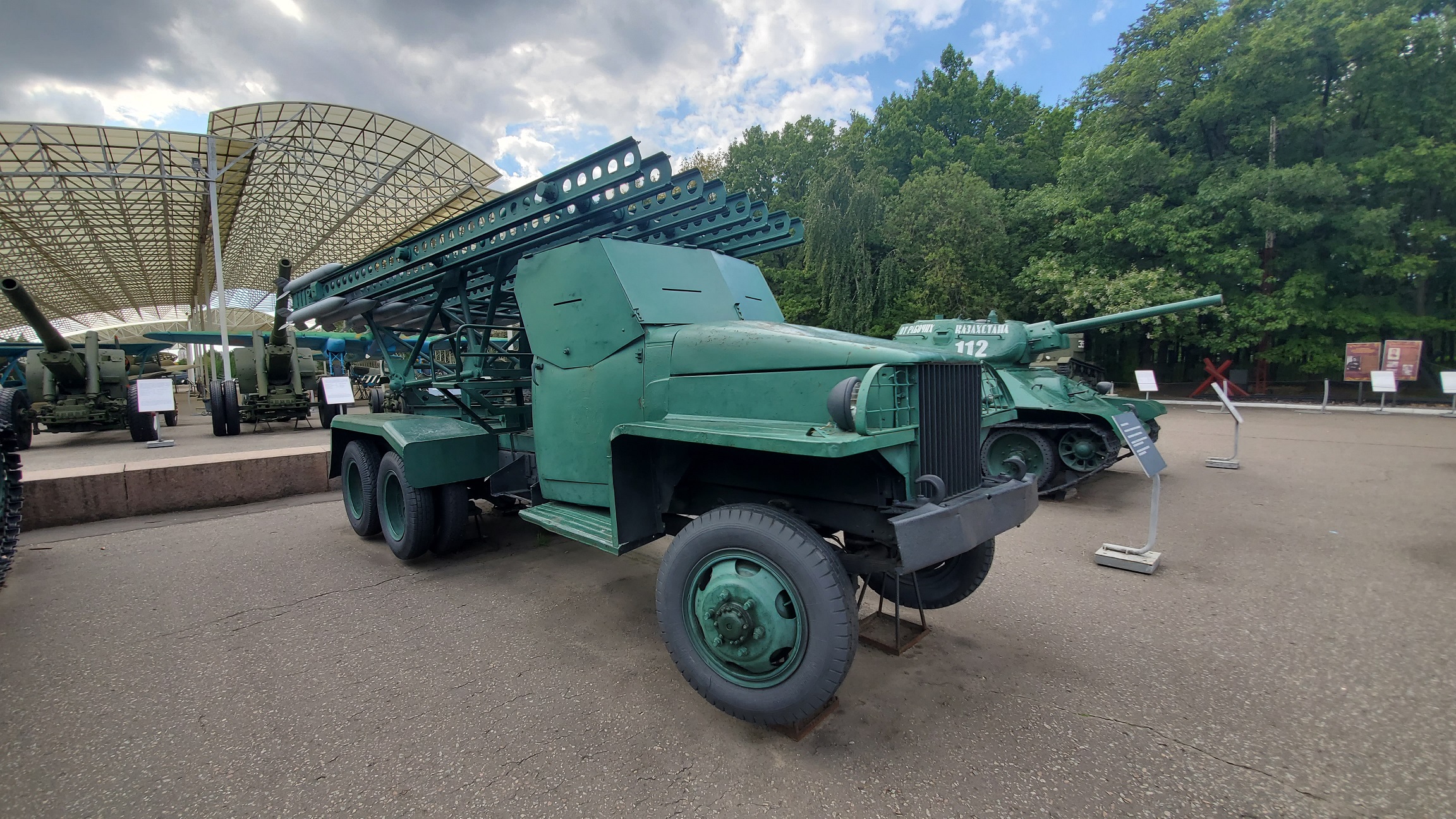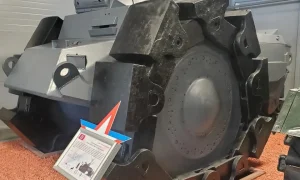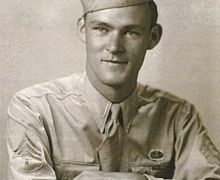BM-13 Katyusha
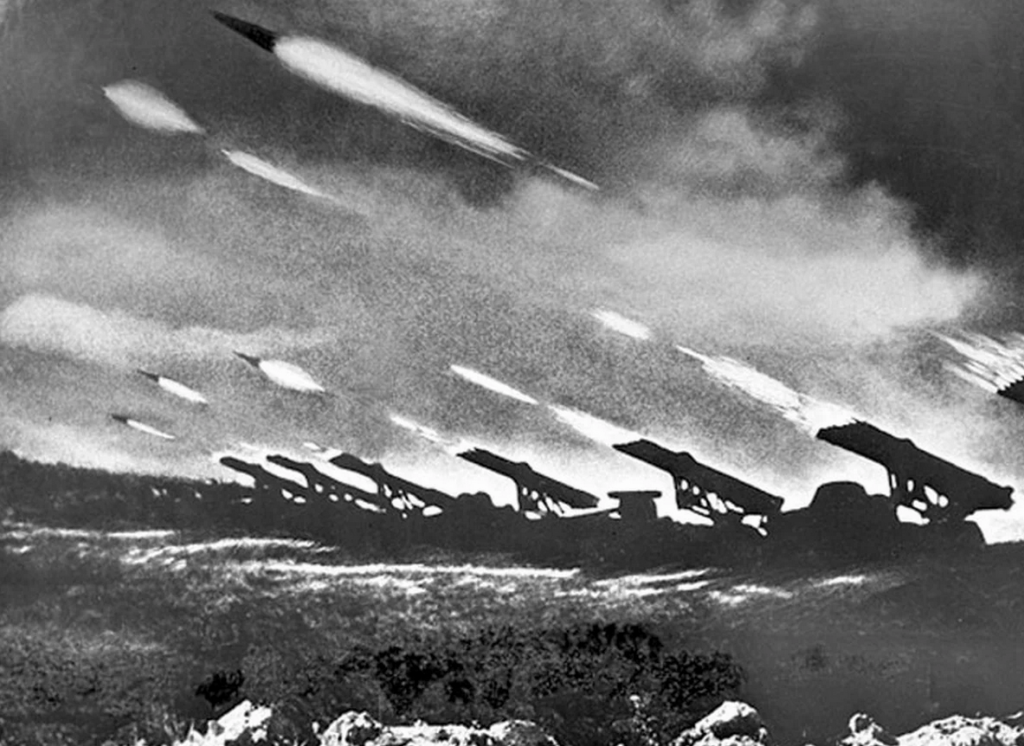
Katyusha Firing
BM-13 Katyusha – Soviet rocket artillery combat vehicle, during the Great Patriotic War, Most widely known by the popular nickname “Katyusha”, the soldiers of Nazi Germany called it “Stalin’s organ” because of the sound made by the plumage of missiles.
BM-13 “Katyusha” HISTORY
The first experimental launchers BM-13 on the chassis of the ZIS-6 machines were manufactured in June 1941 in the amount of eight pieces – two in Voronezh, at the Comintern plant and six in Moscow at the NII-3 NKB USSR, moreover one unit was sent to Sevastopol for testing. Therefore, seven installations were used to form the first experimental battery in the Moscow Military District (commander – Captain I. Flerov ).
During the 4 years of the war, out of 3374 automobile chassis used to mount launchers of guards jet mortars, US6 Studebakers account for 1845 – 54.7%, ZIS-6 – 372 – 11%, the remaining 17 types of chassis – 1 157 – 34.3%. However, these data are questionable, because:
The creation of the MLRS BM-13 was preceded by the creation in the 1930s in the USSR of rockets for aviation RS-132 of the air-to-ground class and RS-82 of the air-to-air class. In 1939, NII-3 (during the Second World War it was evacuated to Bilimbay ) developed 132-mm high-explosive fragmentation projectiles M-13 and a ground-based launcher MU-1 (“mechanized installation”) based on the ZiS-5 with 24 guides. In the same year, an improvement was carried out and the MU-2 installation with 16 guides was created ( Galkovsky V.N.), which, after successful tests, was adopted under the name BM-13 (“combat vehicle, projectile caliber 13 cm”). The installation was carried out in small batches, as were the rockets for it. Initially, production is being established at the Zavod im. Comintern” in Voronezh (evacuated in the spring of 1942 to Sverdlovsk ). In June 1941, production begins at the Kompressor plant in Moscow (at the end of 1941, the plant was evacuated to Chelyabinsk ), from September 1941 – even at the Zavod im. Karl Marx” in Leningrad. The ZiS-5 and ZiS-6 were used as chassis. Due to the lack of automobile chassis, as well as their low cross-country ability, in October 1941, the BM-13 was developed on the Compressor based on the T-60 tank.and with the STZ-5 tracked chassis, the latter version was put into service in November 1941. After the exhaustion of the produced stocks of STZ-5 and its insufficient characteristics, further production on its basis is terminated. Installations are also mounted on Lend lease vehicles (Ford-Marmont, International, Jamesy (GMC), Austin, Studebaker, etc.). In June 1942, the high-explosive rocket M-20 of 132 mm caliber was adopted.
In addition to these plants, during the Second World War, BM-13 was also produced in Chelyabinsk (Chelyabkompressor, Kolyushchenko plant), Sverdlovsk (Ural Compressor Plant, Uralelektroapparat), Kirov (Kuibyshev plant evacuated from Kolomna), Penza (mechanical plant), Gorky (milling machine plant), Kharkov (Shevchenko plant), Moscow (Krasnaya Presnya plant). As a result, this led to some design changes when adapting to the technological processes of factories, which in turn had a negative impact on the interchangeability of units and the training of personnel. In this connection, in 1943, “Compressor” developed a unified standardized version of the BM-13N (“N” – meant “normalized”) with 16 guides (groupRudnitsky V. A. under the general supervision of V. P. Barmin ). In April 1944, the high-explosive fragmentation rocket M-13UK (“UK” – “improved accuracy”) was adopted, and in October 1944 the high-explosive fragmentation M-13DD (“long-range, double”, with a double rocket engine with intermediate nozzle). All 4 types of projectiles could be launched from both the BM-13 and BM-13N, but the use of the M-13DD led to burnout of the guides, in connection with which the BM-13SN (“SN” – “spiral guides”) was designed and produced with 10 rails.
Similarly, there was an “adaptation” of the RS-82 for ground purposes, in August 1941, an 82-mm M-8 rocket projectile was developed (initially modification TS-11, later modifications TS-12 and TS-34). For their use, the “Compressor” creates the BM-8-36 (“combat vehicle, projectile caliber 8 cm, 36 guides”, 38 guides were originally provided), which uses the experience and some components of the BM-13. Produced by “Compressor” and “Krasnaya Presnya”. It was mounted on the chassis of the ZiS-5, ZiS-6, Ford Marmont, Studebaker, T-40 and T-60 tanks. BM-8-24s were also mounted on tank chassis. From the second half of 1942, a modified version began to be produced, BM-8-48 mounted on the chassis GAZ-AAA, Ford-Marmont, Studebaker. By the end of the war, tests of the BM-8SN with spiral guides were carried out, after the end of the war they were not mass-produced.
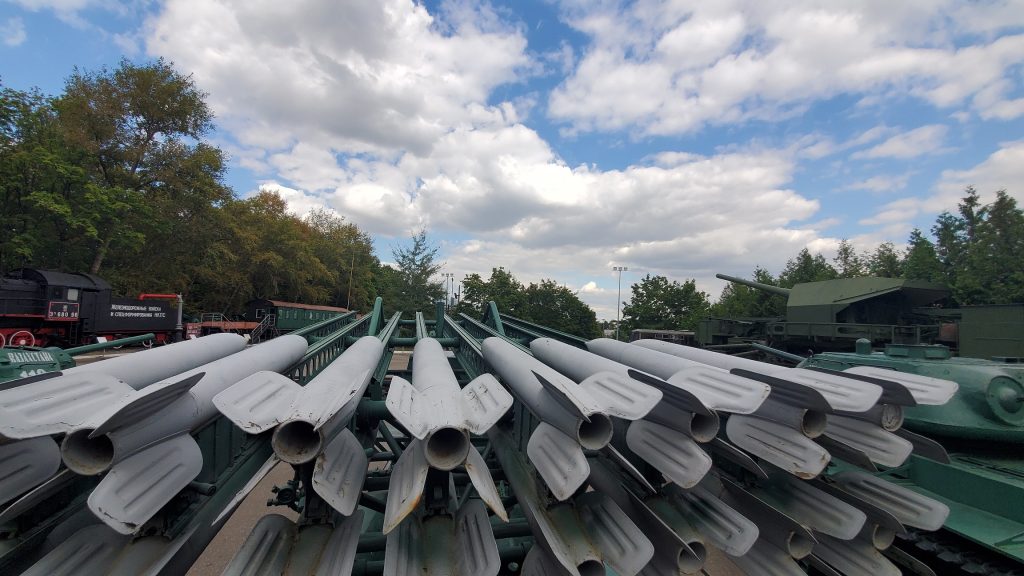
Katyusha rockets
In 1942, in besieged Leningrad, the M-28 turbojet shells (or MTV-280 from “heavy rotating mine of 280 mm caliber”, high-explosive) and M-32 (or MTV- 32, incendiary), whose corking frame wooden box served at the same time as part of the launcher. By the fall, self-propelled launchers with them LAP-7 (“LAP” – “Leningrad Artillery Range”) were created on the GAZ-AAA chassis with a transverse arrangement of launch frames. In May 1942, the M-30 rocket projectile was developed and adopted.caliber 300 mm (warhead) equipped with a jet engine from the M-13. It was launched from a frame dismantled during transportation of a steel launcher of the same name (M-30) developed by Kompressor, while the capping of the projectile served simultaneously as part of the launcher guide. The capacity of the launcher was originally 4 capping boxes of shells, in July 1942 it was upgraded to 8. By the end of 1942, a more powerful and long-range missile M-31 was being developed., which were initially launched from M-30 launchers, later from M-31 launchers, upgraded from 8 to 6 chargers in 1944. At the same time, in August 1942, the M-30 launcher was upgraded to enable it to fire M-20 rockets from the BM-13, for which a removable beam-type guide was provided. By the end of 1943, Kompressor designed a mobile version of the M-30 launcher on the ZiS-6 chassis, but it was not produced due to the lack of a chassis by that time, and at the beginning of 1944 the BM-31-12 launcher on the chassis was put into service. Studebaker. In April 1944, the M-31UK missile was put into service.
Modernizations
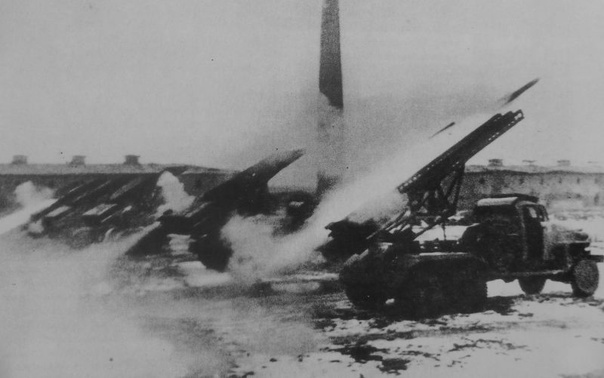
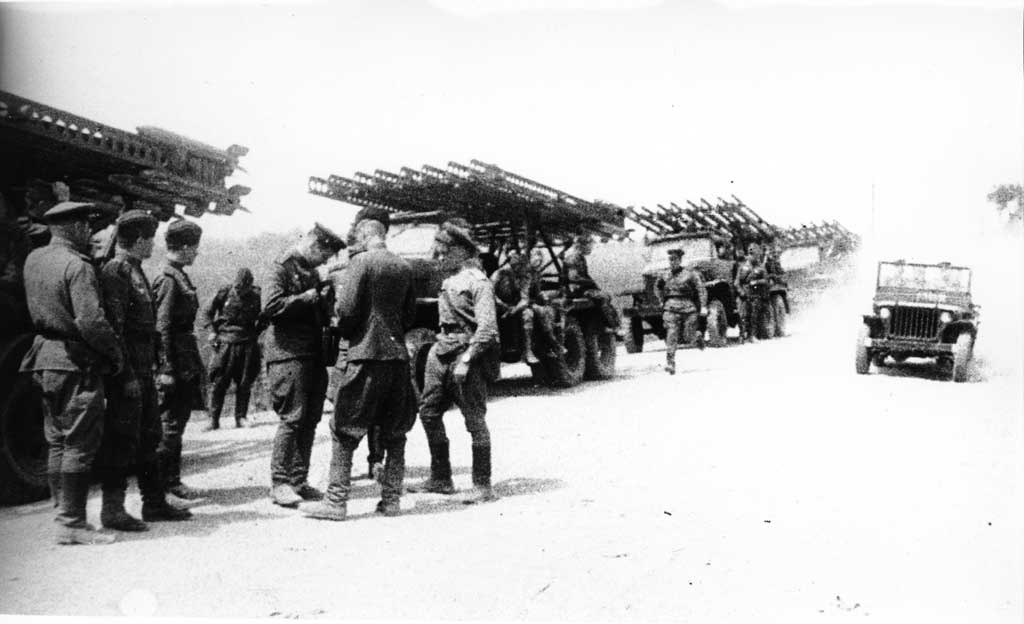
- BM-13N – the basic version on the chassis of the Studebaker YUS6 car, in service since 1943, in 1948 – on the ZIS-150
- BM-13NN (GRAU Index – 52-U-941B) – a variant on the chassis of the ZIS-151 car, put into service in 1949 (first modernization)
- BM-13NM (GRAU index – 2B7) – a variant on the chassis of the ZIL-157 car, put into service in 1958 (second modernization)
- BM-13NMM (GRAU index – 2B7R) – a variant on the chassis of the ZIL-131 car, put into service in 1966 (third modernization and last)
The weapon is relatively simple, consisting of rail guides and their guidance device. For aiming, swivel and lifting mechanisms and an artillery sight were provided. There were two jacks at the rear of the vehicle, providing greater stability when firing. One machine could accommodate from 14 to 48 guides.
The body of the rocket (rocket) was a welded cylinder, divided into three compartments – the warhead compartment, the engine compartment (combustion chamber with fuel) and the jet nozzle. The M-13 rocket projectile for the BM-13 ground installation had a length of 1.41 meters, a diameter of 132 millimeters and a mass of 42.3 kg. Inside the cylinder with plumage was solid nitrocellulose. The mass of the warhead of the M-13 projectile is 22 kg. The explosive mass of the M-13 projectile is 4.9 kg – “like six anti-tank grenades.” Firing range – up to 8.4 km.
The duration of a volley for the BM-13 (16 shells) is 7-10 seconds, for the BM-8 (24-48 shells) it is 8-10 seconds; loading time – 5-10 minutes. The launch was carried out by a handle electric coil connected to the battery and contacts on the guides – when the handle was turned, the contacts closed in turn and the starting squib was fired in the next of the shells. Very rarely, with a large number of guides on the installation, two coils were used simultaneously.
With twice the explosive charge than the Nebelwerfer”, the damaging effect on unarmored vehicles and manpower was much stronger. This was achieved by increasing the gas pressure of the explosion due to the counter movement of the detonation. The explosive was detonated from two sides (the length of the detonator was only slightly less than the length of the cavity for the explosive), and when two detonation waves met, the gas pressure of the explosion at the meeting point increased sharply, as a result of which the body fragments had a much greater acceleration, heated up to 600-800 ° C and had a good ignition effect. In addition to the hull, a part of the rocket chamber was also torn apart, glowing from the gunpowder burning inside, this increased the fragmentation effect by 1.5-2 times compared to artillery shells of a similar caliber. That is why the legend of the “termite charge” in the ammunition “Katyusha”. The thermite charge was tested in Leningrad in the spring of 1942, but it turned out to be redundant – after the volley of Katyushas, everything was on fire anyway (from the collection “Katyusha Guards”). The combined use of dozens of missiles at the same time also created the interference of explosive waves, which further enhanced the damaging effect.
Katyusha Application
The Great Patriotic War
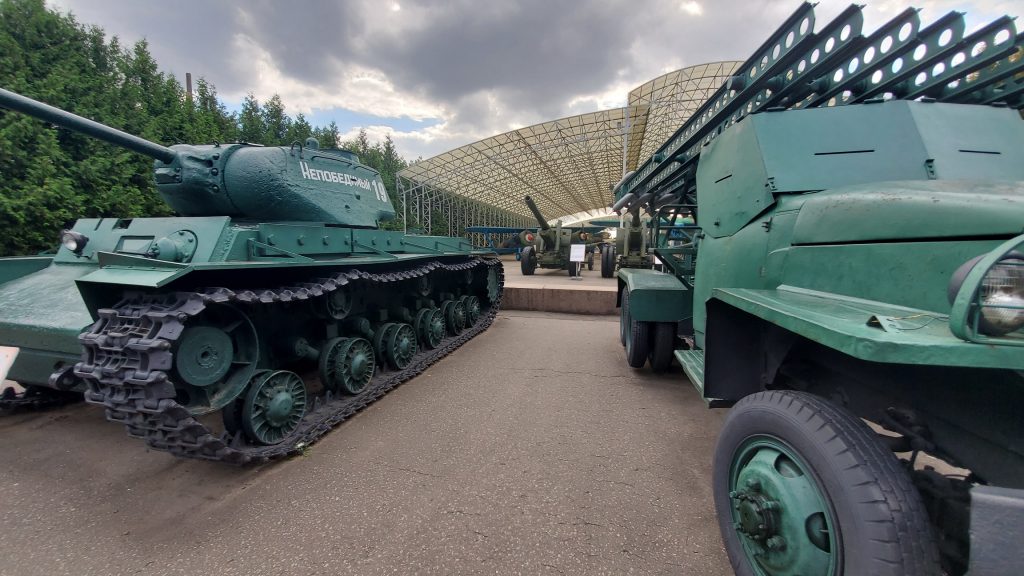
Katyusha Bm13 At Museum
Volley division BM-13-16 during the Battle of Stalingrad. October 6, 1942
Since the advent of rocket artillery (RA), its formations have been subordinate to the Supreme High Command. They were used to reinforce infantry divisions defending in the first echelon, which significantly increased their firepower and increased stability in a defensive battle.
The first use of the novelty took place on July 14, 1941: a battery of installations under the command of Captain Flerov struck at a concentration of enemy troops at the Orsha station.
G.S. Nadysev, head of the artillery combat training department of the headquarters of the Southwestern Front, recalled his impressions of the new weapon:
“… At the end of August 1941, a significant event took place: for the first time, a battery of M-13 rocket launchers, the famous Katyushas, arrived at the front. The chief of artillery, General Parsegov, instructed me to participate in the introduction of new weapons into battle and in the development of tactics for their combat use. Previously, I got acquainted with the battery and talked with the personnel. Having carried out a thorough reconnaissance of firing and waiting positions and having received information from the intelligence department of the front headquarters about the withdrawal of fascist troops to the Desna and the concentration of their large forces in the Oster-Chernigov sector, on August 28 the battery entered a waiting position. To ensure the safety of the battery, the firing position was chosen on the site of the 3rd Airborne Corps, one kilometer from the Desna, against the village of Okuninovo. The corps commander, General V.A. Glazunov occupied an observation post on the river bank. At this time, a large German motorized unit approached the village: the kitchens began to smoke, the soldiers rushed around the yards to catch chickens, women were heard crying, and shooting was heard. The corps commander decided that a fire strike should be delivered immediately, without waiting for the enemy to start active operations. Stopped only by the thought of the fate of the villagers, who could also become victims of our fire.
And then, as if reading the thoughts of the corps commander, almost the entire German unit poured ashore to swim and rest after a tiring march. Such an opportunity could not be missed, and the corps commander ordered me to act. I gave the signal to move the battery to the firing position. After a quick but thorough preparation of data for firing, the Katyushas fired a volley. The shells accurately covered a group of enemy soldiers and officers bathing and resting on the shore. Panic set in. On the shore, screaming heart-rendingly, jumped out a few survivors of the Nazis. A large military unit, having not yet had time to join the battle, actually ceased to exist. It was a huge success, and especially in those days. Everyone who was at the observation post was shocked by the picture of what was happening and the strength of the volley. After all, this is the first time we’ve seen it. First, a large cloud of smoke mixed with the ground rose above the firing position, and then, with an unusual hiss of hearing, oblong dark arrows of mines with a tongue of flame on their tail rushed towards the enemy. In a matter of seconds, dozens of explosions covered a large area on which enemy soldiers were casually chilling just a minute ago. Subsequently, the prisoners told with horror what they experienced, unexpectedly coming under fire from an unknown terrible weapon…. Encouraged by the success of the battery fire strike, I decided to fire a second salvo, shifting the fire to a neighboring sector, where a significant concentration of German infantry and tanks was noticed. General Glazunov approved this decision. After 20 minutes they fired a second salvo, the effect was the same. General Glazunov, looking at the Nazis, distraught with fear, repeated in delight: “They gave it so much!” After the second salvo, Me-109 fighters flew into the firing position, but were late. The battery was already far away. It was then that I realized why the instructions forbade firing two volleys from the same position. This was correct for the initial period of the war, when the Germans had air superiority. When firing, especially in dry weather, and even if the firing position is located on plowing or crops, columns of dust rise above it to a height of up to 100 meters, sharply unmasking the battery. Fortunately for us, the pilots were late with the flight. Two M-13 battery volleys did what two artillery battalions of 122-millimeter howitzers could not have done during this time. As the prisoners taken in the sector of the 3rd Airborne Corps later showed, the Germans suffered heavy losses from these volleys – from explosions of 128 powerful shells. The high performance of the new Soviet weapons amazed the Nazis. I received, and deservedly, a fair scolding for the second volley from the same position. But, as you know, the winners are not judged… But when a little later I had to bring into battle near the Zhikhor station in the Kyiv region another battery of rocket artillery – M-8, I acted more prudently.
The requirements for the use of new weapons – massiveness and surprise – were reflected in the Directive of the Headquarters of the Supreme High Command No. 002490 of October 1, 1941.
During the battle for Moscow, due to the difficult situation at the front, the command was forced to use rocket artillery divisionally.
But by the end of 1941, the number of rocket artillery in the troops increased significantly and reached 5-10 divisions in the armies operating in the main direction. Managing the fire and maneuver of a large number of divisions, as well as supplying them with ammunition and other types of allowances, became difficult. By decision of the Headquarters of the Supreme High Command in January 1942, the creation of 20 guards mortar regiments began.
By the end of 1942, there were already 4 Guards mortar divisions, 8 regiments, 72 separate divisions, and by 1945 – 7 rocket artillery divisions, 11 brigades, 114 regiments, 38 separate divisions.
The “Guards mortar regiment (guards minp) of the artillery of the Reserve of the Supreme High Command ( RVGK )” according to the state consisted of management, three divisions of a three-battery composition. Each battery had four combat vehicles. Thus, a volley of only one battalion of guards mortars from 12 BM-13-16 vehicles (Stavka directive No. 002490 forbade the use of rocket artillery in an amount less than a battalion) could be compared in strength with a volley of 12 heavy howitzer regiments of the RVGK (48 howitzers of 152 mm caliber per regiment ) or 18 RVGK heavy howitzer brigades (32 152 mm howitzers per brigade).
The psychological effect was also important: during the salvo, all missiles were fired almost simultaneously – in a few seconds, the ground in the target area was literally plowed up by rockets. The mobility of the installation made it possible to quickly change position and avoid the enemy’s retaliatory strike.
On July 17, 1944, near the village of Nalyuchi, a salvo of 144 launchers equipped with 300-mm rockets – M-30 was heard. This was the first use of a somewhat less famous related weapon – “Andryusha”.
In July-August 1942, the Katyushas (three regiments and a separate division) were the main striking force of the Mobile Mechanized Group of the Southern Front, which held back the advance of the German 1st Panzer Army south of Rostov for several days. This is reflected even in the diary of General Halder: “increased Russian resistance south of Rostov.”
In August 1942, in the city of Sochi, in the garage of the Caucasian Riviera sanatorium, under the leadership of the head of the mobile repair shop No. 6, a military engineer of the III rank A. Alferov, a portable version of the installation was created on the basis of M-8 shells, which later received the name “mountain Katyusha”. The first “mountain Katyushas” entered service with the 20th Mountain Rifle Division and were used in battles at the Goyth Pass. In February – March 1943, two divisions of “mountain Katyushas” became part of the troops defending the legendary bridgehead on Malaya Zemlya near Novorossiysk.
In the 62nd Army in Stalingrad, on the basis of the T-60, the 4th Guards Mortar Regiment “Katyusha” fought, which was directly subordinate to Commander V.I. Chuikov. During the battle, Katyushas used exclusively M-8 shells, in the CAT modification (thermite). The temperature at the site of the explosion instantly rose to 4000 degrees Celsius. It was the use of these shells that was the root cause of the origin of the very name “Katyusha”. The presence at the disposal of Commander Chuikov V.I., a recognized master of close combat, an entire regiment of “Katyushas” armed with thermite ammunition, allowed him with his headquarters in the most formidable days of the battle to be on the front line 400 meters from the enemy line, three hundred meters behind him was located 4th Guards Mortar Regiment “Katyusha” under the command of Colonel Erokhin A.I. Any attempts to attack the Germans in this area were immediately suppressed by a volley of thermite shells of rocket artillery. The commander himself writes about this in his book “The Battle of the Century”. After the Battle of Stalingrad, for certain reasons, the use of thermite shells was discontinued. There is a legend that an ultimatum was presented to the enemy High Command, in which the German command threatened to start using chemical weapons if the Red Army did not stop using KAT thermite shells. This legend deserves attention for the reason that the Germans had a truly huge arsenal of chemical weapons, but during the entire war they did not use a single chemical projectile on the Eastern Front. Subsequently, the entire arsenal of Nazi Germany’s chemical weapons was flooded by the victorious countries in the Baltic Sea. The commander himself writes about this in his book “The Battle of the Century”. After the Battle of Stalingrad, for certain reasons, the use of thermite shells was discontinued. There is a legend that an ultimatum was presented to the enemy High Command, in which the German command threatened to start using chemical weapons if the Red Army did not stop using KAT thermite shells. This legend deserves attention for the reason that the Germans had a truly huge arsenal of chemical weapons, but during the entire war they did not use a single chemical projectile on the Eastern Front. Subsequently, the entire arsenal of Nazi Germany’s chemical weapons was flooded by the victorious countries in the Baltic Sea. The commander himself writes about this in his book “The Battle of the Century”. After the Battle of Stalingrad, for certain reasons, the use of thermite shells was discontinued. There is a legend that an ultimatum was presented to the enemy High Command, in which the German command threatened to start using chemical weapons if the Red Army did not stop using KAT thermite shells. This legend deserves attention for the reason that the Germans had a truly huge arsenal of chemical weapons, but during the entire war they did not use a single chemical projectile on the Eastern Front. Subsequently, the entire arsenal of Nazi Germany’s chemical weapons was flooded by the victorious countries in the Baltic Sea. After the Battle of Stalingrad, for certain reasons, the use of thermite shells was discontinued. There is a legend that an ultimatum was presented to the enemy High Command, in which the German command threatened to start using chemical weapons if the Red Army did not stop using KAT thermite shells. This legend deserves attention for the reason that the Germans had a truly huge arsenal of chemical weapons, but during the entire war they did not use a single chemical projectile on the Eastern Front. Subsequently, the entire arsenal of Nazi Germany’s chemical weapons was flooded by the victorious countries in the Baltic Sea. After the Battle of Stalingrad, for certain reasons, the use of thermite shells was discontinued. There is a legend that an ultimatum was presented to the enemy High Command, in which the German command threatened to start using chemical weapons if the Red Army did not stop using KAT thermite shells. This legend deserves attention for the reason that the Germans had a truly huge arsenal of chemical weapons, but during the entire war they did not use a single chemical projectile on the Eastern Front. Subsequently, the entire arsenal of Nazi Germany’s chemical weapons was flooded by the victorious countries in the Baltic Sea.
In addition, 4 trolley -based installations were created in the Sochi locomotive depot, which were used to protect the city of Sochi from the shore.
The minesweeper “Mackerel” was equipped with eight installations, which covered the landing on Malaya Zemlya
In September 1943, during the Bryansk operation, the Katyusha maneuver along the front line made it possible to carry out a sudden flank attack, as a result of which the German defense was “folded” in the entire front – 250 kilometers. During the artillery preparation, 6,000 rockets and only 2,000 barrels were used up.
Korean War (1950-1953)
BM-13s were widely used by Chinese volunteers during the Korean War. In particular, the massive use of the BM-13 made a significant contribution to the Chinese counteroffensive during the Battle of the Triangular Hill, which began on October 30, 1952. On that day, the 15th Corps of People’s Volunteers fired 133 large-caliber guns, 22 BM-13 Katyushas and 30 heavy 120-mm mortars at the UN Sheep for 12 hours in the largest Chinese artillery operation of the entire war.
Vietnam War (1955-1979)
BM-13s were widely used during the first and second Indochina wars.
Afghan war (1979-1989)
Between 1961 and 1963, the USSR delivered a number of BM-13s to the Kingdom of Afghanistan, which were used by government forces at the initial stage of the Afghan war before they were replaced by Soviet deliveries of BM-21s.


